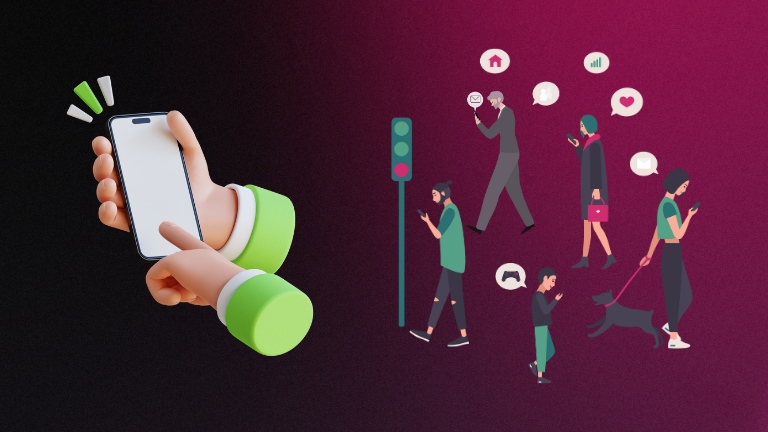In a quiet café in Austin, a student unlocks her foldable phone, snapping it open like a book. Across the world in Nairobi, a small business owner checks new orders on his budget smartphone powered by 5G. Meanwhile, a traveler in Tokyo books a hotel using voice commands through their phone’s AI assistant.
These small moments paint a vivid picture: smartphones are no longer just devices, they’re lifelines. As we step into 2025, the smartphone industry stands at a defining point, merging cutting-edge innovation with deep-rooted global dependence. Let’s break down the latest smartphone data shaping this evolving landscape.
Editor’s Choice
- 1.56 billion smartphones are projected to be shipped globally by the end of 2025, a rise of 3.8% from the previous year.
- Foldable smartphones are expected to account for 6.2% of total smartphone shipments in 2025.
- The global smartphone user base has now surpassed 5.7 billion, meaning over 71% of the world’s population owns a smartphone in 2025.
- India has overtaken the US as the second-largest smartphone market, boasting 1.16 billion active devices as of early 2025.
- The average smartphone replacement cycle has stretched to 44 months in 2025.
- In 2025, 59% of all smartphones sold will come with AI-powered processors, signifying a sharp shift toward smart automation.
- Global smartphone revenue is forecast to hit $647 billion in 2025, with premium models (over $800) accounting for 38% of that total.
Global Smartphone Market Share Breakdown
- Apple dominates the market with a strong 23.2% share worldwide.
- Samsung trails behind, capturing 15.6% of the global share.
- Xiaomi holds a notable position with 12.9% of the market.
- Both Vivo and Transsion tie with an equal 8.2% market share each.
- The remaining brands collectively account for a substantial 32% of the global smartphone market.
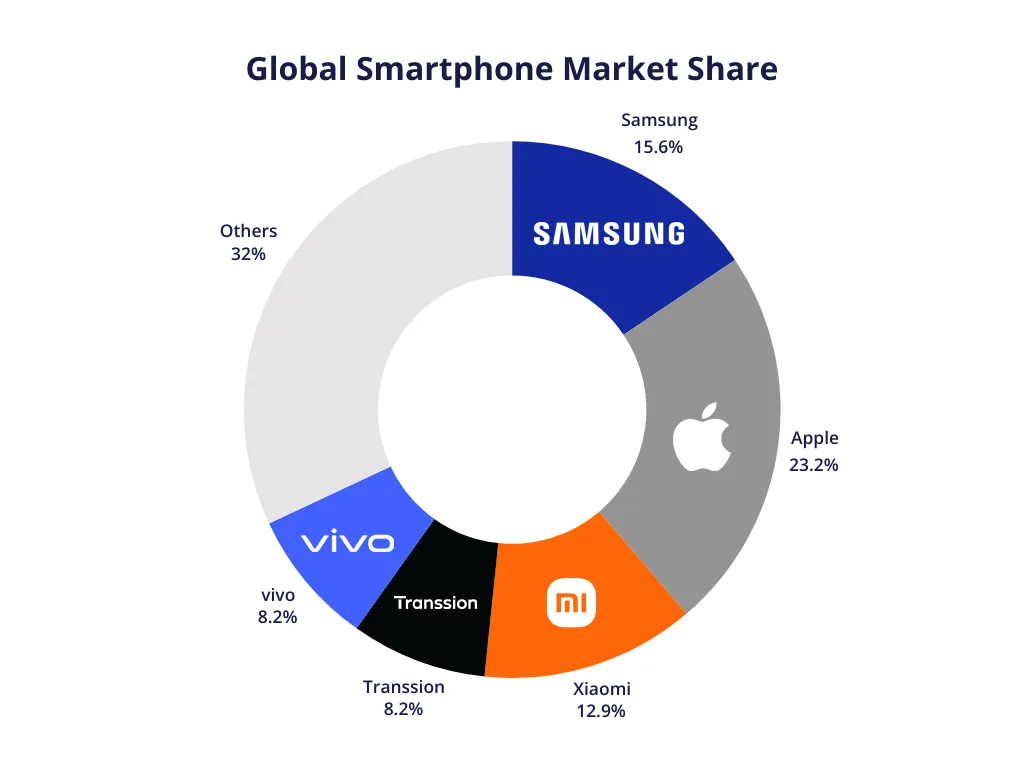
Annual Smartphone Shipment Volumes
- Global smartphone shipments are projected to reach 1.56 billion units in 2025, showing steady recovery from earlier supply chain disruptions.
- The United States is set to ship 163 million smartphones in 2025, reflecting a modest 2.2% annual growth.
- China remains the largest contributor with approximately 340 million units shipped in 2025, though its growth rate has plateaued.
- Europe will see a slight rise, reaching around 215 million smartphone shipments in 2025, driven largely by Eastern markets.
- Mid-range smartphones priced between $300 and $600 are dominating with 42% share of total shipments globally.
- 5G smartphones will comprise 76% of total global shipments in 2025.
- The average selling price (ASP) of a smartphone has increased to $412 in 2025, pushed up by innovation in foldables and camera tech.
- Apple maintains its leadership in global revenue share with 27%, despite only holding 18% of unit shipments.
- Samsung leads in volume with 22% global share, shipping an estimated 343 million smartphones in 2025.
- The smartphone resale market is booming, with 120 million refurbished devices expected to be shipped this year.
Smartphone Adoption in Emerging Markets
- India has reached a smartphone penetration rate of 81% in 2025, with rural areas accounting for 48% of new users.
- In Nigeria, smartphone adoption has surpassed 57% as of mid-2025, marking one of the fastest-growing markets globally.
- Brazil saw a 10% year-over-year increase in smartphone users, bringing total penetration to 83% in 2025.
- Indonesia now has over 200 million smartphone users, reaching 72% market penetration.
- Bangladesh saw a surge with 34 million new users in 2025, pushing its adoption rate to 63%.
- Kenya‘s smartphone market grew by 14% this year, largely driven by mobile-first fintech platforms.
- Vietnam’s smartphone penetration is now 89%, helped by affordable 5G Android devices.
- Pakistan’s smartphone adoption hit 64% in 2025, with heavy investment from Chinese manufacturers.
- Entry-level smartphones under $150 accounted for 43% of total sales across Sub-Saharan Africa in 2025.
- Governments in emerging markets have launched digital literacy programs targeting 70 million first-time users in 2025.
Global Growth in Smartphone Users
- By 2028, smartphone usage is projected to reach a staggering 5.83 billion worldwide.
- Back in 2014, there were only 1.03 billion smartphone users around the world.
- The number jumped to 1.22 billion in 2015, marking a steady rise.
- 2016 saw a continued increase, reaching 1.4 billion users globally.
- By 2017, smartphone adoption rose to 1.58 billion users.
- In 2018, the figure climbed to 1.84 billion.
- The global user base hit 2.16 billion in 2019, surpassing the 2-billion mark.
- 2020 recorded a sharp increase with 2.58 billion smartphone users.
- In 2021, the number reached 2.95 billion, nearing the 3-billion milestone.
- By 2022, global users totaled 3.39 billion.
- 2023 continued the growth trend with 3.77 billion users worldwide.
- The 2024 projection points to 4.25 billion smartphone users.
- For 2025, the expected number is 4.69 billion, continuing the upward momentum.
- 2026 is forecasted to cross the 5-billion threshold with 5.12 billion users.
- Estimates for 2027 show a rise to 5.49 billion users globally.
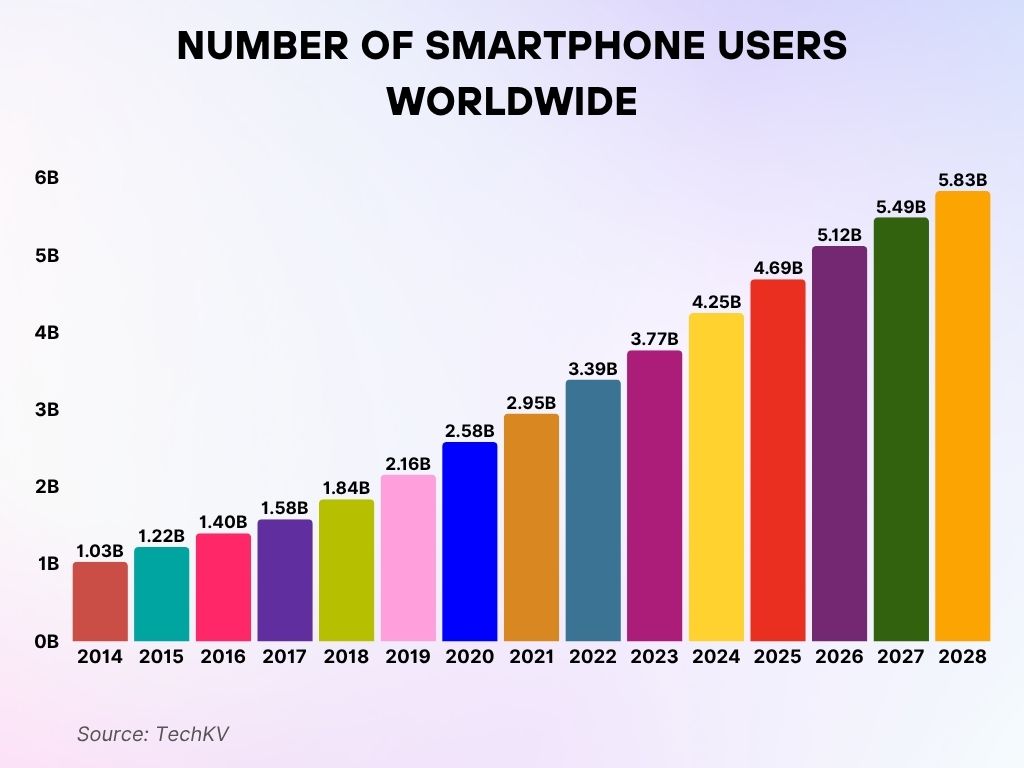
Trends in Foldable and Dual-Screen Smartphones
- Foldable smartphone shipments are projected to hit 96 million units globally in 2025.
- Samsung Galaxy Z Fold 6 leads the category, accounting for 32% of all foldables shipped this year.
- Dual-screen devices now make up 2.5% of total high-end smartphone sales globally.
- China leads in foldable adoption with over 41 million units shipped domestically in 2025.
- The average price of foldables has dropped to $1,038, down 11% from last year, widening their accessibility.
- Flip-style foldables outsell book-style models in 2025, capturing 57% of foldable shipments.
- Durability has improved dramatically; 76% of users report satisfaction with crease resistance in 2025 foldables.
- Battery life in foldables now averages 11.2 hours of active screen time, closing the gap with traditional smartphones.
- Google Pixel Fold 2 holds a 12% market share in the US foldable segment.
- OLED flexible displays are used in 92% of foldables in 2025, replacing early hybrid panels.
Impact of Smartphones on E-Commerce Growth
- 72% of all e-commerce transactions in 2025 are conducted via smartphones.
- Mobile retail apps see an average conversion rate of 3.5%, outperforming desktop at 2.1%.
- The global m-commerce market is expected to reach $4.6 trillion by the end of 2025.
- Voice-assisted shopping on smartphones grew 29% YoY, now used by 19% of online buyers.
- In the US, mobile-first retailers saw 18% higher average order values compared to desktop users.
- Social commerce, buying directly through social media apps on smartphones, accounts for 17% of global e-commerce sales.
- Latin America experienced a 38% increase in smartphone-driven e-commerce transactions in 2025.
- The average mobile session time for shopping apps increased to 9.8 minutes this year.
- QR code usage for payments rose 22% in 2025, especially in urban Asia.
- Mobile wallet integration is now a standard feature for 94% of all major shopping apps.
Top Places People Use Their Smartphones
- 14% use their phones while walking the dog, proof that our screens follow us everywhere.
- 17% stay connected on the bike, blending movement with mobile engagement.
- 63% use smartphones in the bathroom, showing that privacy doesn’t pause connectivity.
- 69% turn to their devices at the airport, relying on them during travel downtime.
- 70% scroll in bed, making late-night usage a near-universal habit.
- 72% multitask with their phones in the kitchen, merging recipes, music, and calls.
- 77% browse or chat at restaurants, where dining now meets digital.
- 80% use smartphones while shopping, tapping into reviews and deals in real time.
- 88% go online on public transport, transforming commutes into screen time.
- 91% stay connected on the go, as mobile usage becomes second nature in motion.
- 91% also use phones at work, showing how mobile tech dominates professional life.
- 98% use their smartphones at home, making it the #1 location for mobile activity.
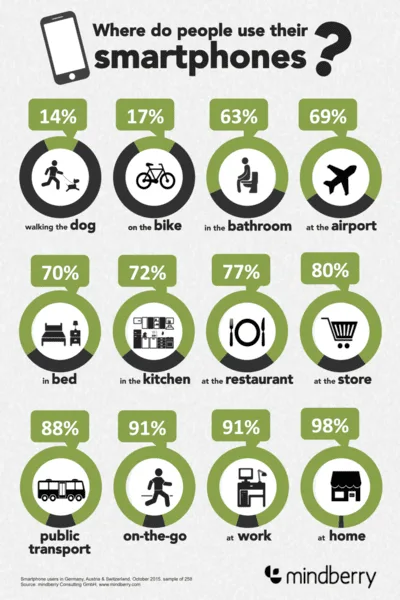
Voice Assistant Usage on Smartphones
- In 2025, over 2.1 billion smartphone users globally use voice assistants at least once per week.
- 38% of all mobile searches are now conducted through voice.
- Siri remains the most used assistant in the US, with a 31% market share among smartphone voice assistant users.
- Google Assistant usage on Android smartphones grew by 17%, powering over 620 million devices worldwide.
- Amazon Alexa’s mobile integrations have doubled year-over-year, now installed on 110 million smartphones.
- In India, voice assistants are used by 61% of smartphone owners, driven by regional language support.
- The average voice command session lasts 2 minutes, indicating broader task engagement.
- Shopping via voice on smartphones grew by 22%, with 13% of users having made at least one purchase using voice in 2025.
- Privacy concerns remain a top barrier, with 41% of non-users citing data collection fears as the reason for avoiding voice assistants.
- Automotive voice integration with smartphones expanded by 36%, now embedded in 67 million vehicles.
Smartphone Camera Usage and Trends
- In 2025, 89% of smartphone owners use their camera daily, with photo messaging being the most common purpose.
- 4K video recording capability is now present in 74% of new smartphones sold globally.
- The average megapixel count for rear cameras hit 64MP.
- AI photography modes, such as automatic night mode and object removal, are used by 56% of users at least weekly.
- Portrait mode continues to dominate, accounting for 31% of all smartphone photos shared on social media.
- Selfies make up 28% of all smartphone images captured, with ultra-wide selfie lenses now in 47% of smartphones.
- In 2025, 70% of Gen Z users say a camera is their most important feature when buying a new phone.
- Optical zoom has improved, with 43% of new devices offering 5x or greater zoom without digital cropping.
- The average user stores 6,400 photos on their smartphone, up from 5,800 last year.
- Photo editing apps have reached 1.3 billion installs globally, driven by content creators and influencers.
Smartphone Users by Country
- Vietnam has over 61.37 million smartphone users, reflecting growing digital adoption in Southeast Asia.
- Germany counts 65.24 million users, showcasing strong penetration in Europe.
- Mexico has reached 70.14 million users, highlighting Latin America’s expanding mobile base.
- Japan is home to 75.77 million users, blending tech-savviness with mobile culture.
- Russia reports a solid 99.93 million smartphone users.
- Brazil has surged to 109.34 million users, driven by its mobile-first population.
- Indonesia boasts 160.23 million users, cementing its place as a major mobile market.
- United States has a powerful base of 270 million smartphone users.
- India ranks second globally with a massive 439.42 million users.
- China leads the world with a staggering 911.92 million smartphone users.
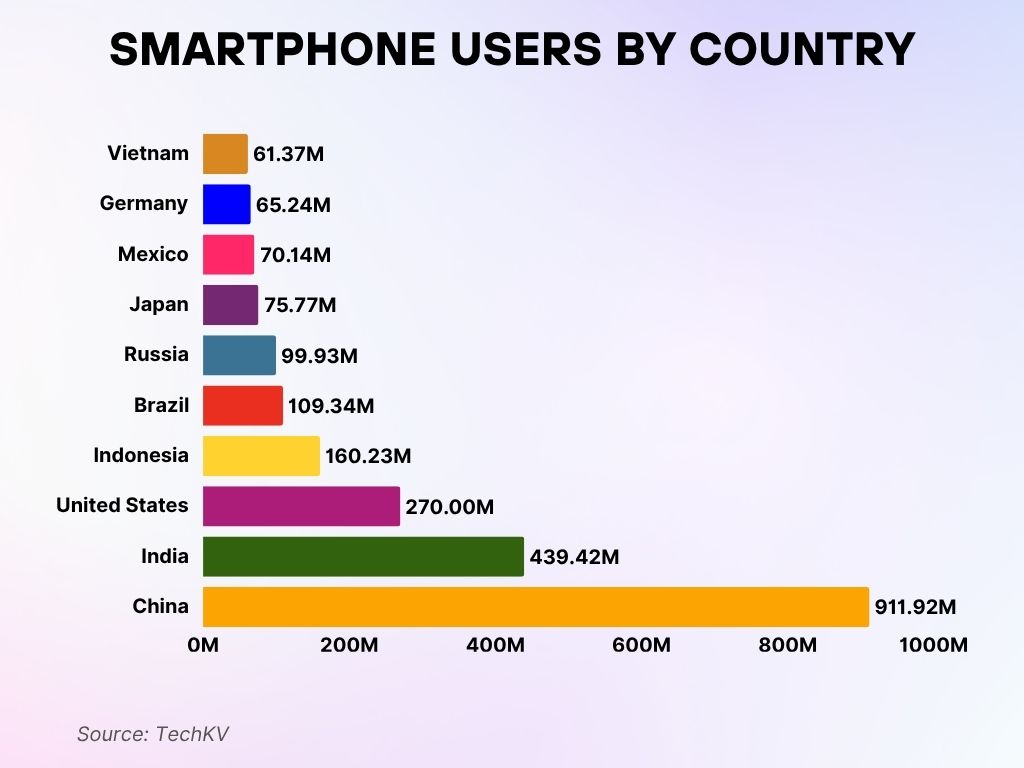
Battery Life Expectations and Charging Behaviors
- The average smartphone battery life is now 11.7 hours of screen-on time in 2025.
- Fast charging of 65W or higher is now available in 61% of smartphones launched this year.
- Wireless charging adoption reached 54%.
- 83% of users charge their phones overnight, while only 17% practice optimized daytime charging.
- Battery anxiety, worrying about battery levels, affects 42% of daily users in 2025.
- The average smartphone user charges their phone 1.4 times per day.
- Battery health monitoring is now a built-in feature in 68% of Android phones and all iPhones.
- Reverse wireless charging is available on 22% of high-end smartphones, up from 15% last year.
- In emerging markets, power-saving modes are used by 57% of users regularly.
- Eco charging features that slow charging at night to preserve battery longevity are found in 31% of devices.
Wearable and Smartphone Ecosystem Integration
- Smartphone-to-wearable pairing has reached 74% among smartwatch users in 2025.
- Apple Watch integration accounts for 62% of wearable connections with smartphones in the US.
- Samsung Galaxy Watches now support full standalone call and text functions, synced with smartphones in 39 countries.
- Google Pixel Watch 2 usage doubled in 2025, now paired with 18 million smartphones globally.
- Fitness tracking via wearables connected to smartphones increased to 63% daily usage.
- Smart ring adoption is growing, with over 21 million units shipped, primarily paired with health-focused apps.
- Bluetooth LE Audio standards enabled multi-device pairing in 45% of all wearables launched this year.
- Voice notifications from smartphones to wearables are actively used by 52% of users under 30.
- Sleep data synchronization between wearables and smartphones saw a 29% increase, especially among Gen Z.
- The average user in 2025 has 3.2 connected devices syncing data with their smartphone.
Top Activities Smartphone Users Do Daily
- 74.7% of users are actively messaging or chatting, making it the #1 global smartphone activity.
- 70.95% check and send emails, showing how smartphones have become essential for professional communication.
- 62.9% handle their banking online, turning smartphones into digital wallets and finance hubs.
- 61.7% stream music, making tunes a part of everyday mobile life.
- 61.1% watch videos, with content consumption continuing to dominate screen time.
- 56.7% search for products online, reflecting how smartphones shape buying decisions.
- 56.6% go further by actually purchasing products, proving the strength of mobile e-commerce.
- 54.55% share content by uploading videos or photos, keeping social media alive and visual.
- 52.3% read news online, with smartphones now serving as personal newsstands.
- 47.45% make internet calls, signaling a shift from traditional voice services to VoIP options.
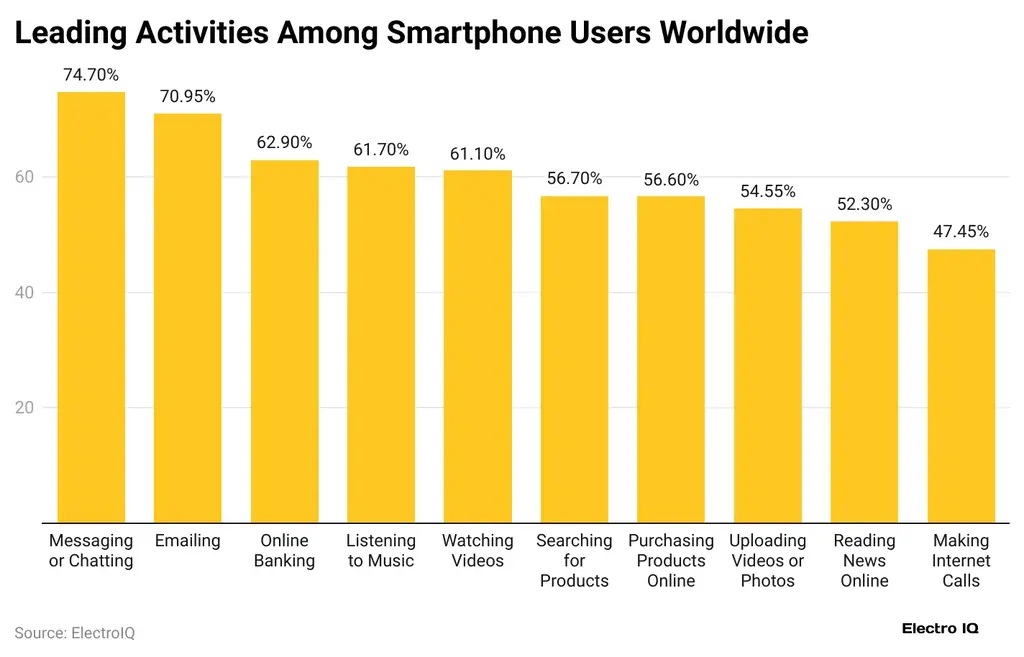
Smartphone Usage During Travel and Commuting
- In 2025, 72% of travelers rely on smartphones as their primary tool for navigation.
- Offline map usage has grown by 19%, driven by international travel and roaming costs.
- Digital boarding passes are used by 84% of airline passengers in the US, up from 77% last year.
- Transit apps see an average open rate of 3.8 times per trip among daily commuters.
- Public transportation payment via smartphones has reached 59% adoption across major urban areas.
- The average US commuter spends 42 minutes per day using a smartphone on public transport.
- Streaming video during commutes increased by 15%, accounting for 32% of all mobile data use on weekdays.
- Navigation apps like Google Maps and Waze account for 21% of battery drain during travel sessions.
- Travel booking via smartphone makes up 61% of all bookings in 2025.
- Language translation apps were used by 68 million international travelers in the first half of 2025.
Consumer Preferences for Smartphone Features
- In 2025, battery life ranks as the top feature for 76% of consumers when choosing a new smartphone.
- Screen refresh rate preferences have shifted, with 41% of users demanding 120Hz or higher.
- Storage remains critical; 64% of buyers prefer 256GB or more internal storage as a baseline.
- AI features, such as real-time translation and smart reply, influence 38% of buying decisions.
- Sustainability is growing in importance: 29% of US consumers say they would pay more for an eco-friendly device.
- Color customization options are now offered by 33% of smartphone brands, meeting rising personalization demand.
- In-display fingerprint scanners are present in 61% of smartphones in 2025.
- Durability matters; 54% of buyers check for IP68 or higher water resistance ratings before purchase.
- Satellite connectivity is emerging in high-end models, now available in 11% of new smartphones.
- Camera-centric models dominate in the $800+ range, preferred by 45% of Gen Z and millennial users.
Daily Smartphone Usage in the US
- Only 5% of Americans spend less than 1 hour on their smartphones each day, a rare digital detox.
- 16% clock in about 1–2 hours daily, showing moderate mobile use.
- 22% spend 3–4 hours per day on their phones, a common sweet spot for most users.
- A hefty 46% are on their smartphones for 4–5 hours daily, making this the most typical usage range.
- 11% go all in, spending over 7 hours every single day on their devices, nearly a full-time job in screen time.
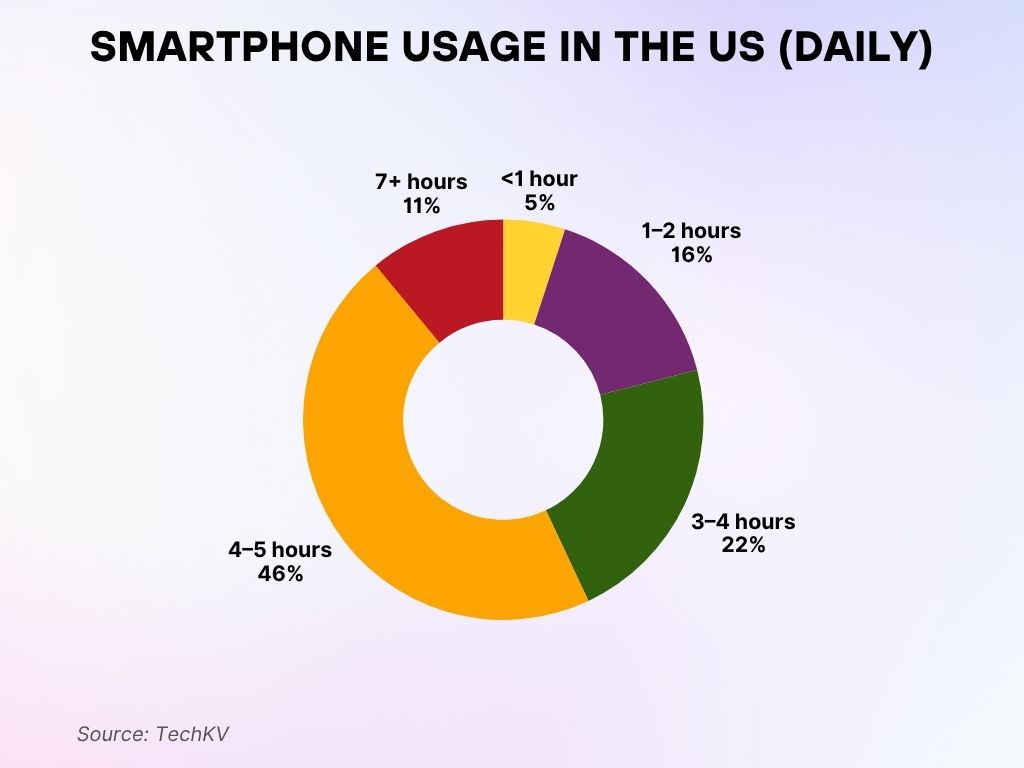
Impact of Smartphone Use on Mental Health
- In 2025, 58% of adults report feeling digitally overwhelmed due to smartphone notifications.
- The average user receives 96 notifications per day.
- Screen time among teens now averages 7.1 hours per day on smartphones.
- Digital wellbeing features like screen time monitors are used by 31% of users, up from 26% last year.
- Sleep disruption caused by late-night phone use is reported by 46% of Gen Z users.
- Social media apps account for 32% of all time spent on smartphones, leading to higher comparisons and stress indicators.
- Mental health apps have grown to 1.1 billion installs worldwide, many integrated with smartphones.
- 85% of psychologists recommend limiting smartphone screen time to under 3 hours of leisure use per day.
- Mindfulness apps, including guided breathing and focus timers, are used by 24% of smartphone owners weekly.
- Digital detox trends continue rising: 18% of users in the US took a break from their phones for 48 hours or more this year.
Trends in Mobile Gaming via Smartphones
- Mobile gaming revenue is projected to hit $108.3 billion globally in 2025.
- 2.9 billion people worldwide play games on smartphones, making it the most-used gaming platform.
- In-app purchases on mobile games have risen 11%, averaging $34.70 per paying user annually.
- Hyper-casual games dominate downloads, accounting for 38% of all installs in mobile app stores.
- Cloud gaming on smartphones has reached 43 million monthly active users.
- Mobile esports viewership is expected to surpass 650 million in 2025, especially in Asia.
- Battery drain from gaming averages 18% per hour on high-performance titles like Genshin Impact and Call of Duty Mobile.
- Gaming smartphones with cooling systems and dedicated GPUs now make up 6% of global shipments.
- Cross-platform gaming is on the rise, with 29% of users switching between mobile and console/PC gameplay.
- AR-based games like Pokémon Go still attract 62 million active users in 2025.
Smartphone Return and Warranty
- The global return rate for smartphones is 6.4%.
- Hardware defects account for 41% of all returned devices, led by screen and battery issues.
- Buyer’s remorse is the cause of 19% of returns, often linked to poor camera quality or size.
- In the US, the average return window across major retailers is now 30 days.
- Extended warranties are purchased by 36% of smartphone buyers, up from 32% last year.
- Accidental damage protection is the most common add-on, opted for by 72% of extended warranty buyers.
- Refurbished returns increased by 9%, often due to outdated software or perceived poor performance.
- AppleCare+ and Samsung Care+ continue to dominate, with combined coverage extending to 118 million devices globally.
- Only 11% of smartphones are returned within the first week of purchase.
- The average resolution time for warranty claims is now 5.6 days.
Recent Developments in the Smartphone Industry
- Apple is set to launch the iPhone 17 Ultra in Q4 of 2025, featuring integrated AI and satellite calling.
- Samsung’s Galaxy AI Suite, introduced in 2025, has rolled out to over 120 million devices globally.
- Xiaomi leads in value innovation, offering 5G, 108MP cameras, and 120Hz screens in devices under $350.
- Huawei returned to global markets with HarmonyOS 4.0, now active on 280 million devices.
- Google launched its Tensor G4 chip, enabling offline AI processing on its Pixel smartphones.
- Fairphone 5, a fully modular and ethically sourced smartphone, gained traction in Europe with over 1.1 million units sold.
- eSIM adoption is at 48% globally, with 80% in developed nations using at least one eSIM-compatible device.
- Smartphone recycling programs collected over 180,000 tons of e-waste in the past year, a 14% improvement.
- On-device generative AI is now embedded in 31% of high-end smartphones.
- Startups like Nothing and Carl Pei’s ventures are reshaping the design space, with minimalist, transparent phone bodies gaining cult followings.
Conclusion
From foldables to AI-powered photography and digital wellbeing features, smartphones in 2025 are no longer just tools; they’re companions, assistants, and creative platforms. Their rapid evolution continues to shape how we live, work, play, and connect. As consumers demand more personalization, performance, and purpose-driven design, the smartphone industry will keep responding with bold innovation. Whether it’s navigating your next trip, launching a business from your pocket, or capturing life’s best moments, smartphones are doing more and demanding less.
